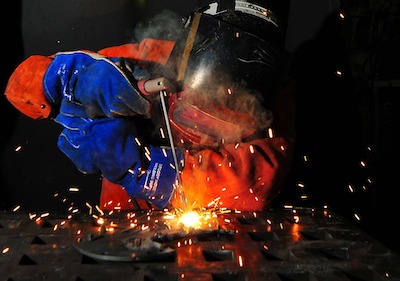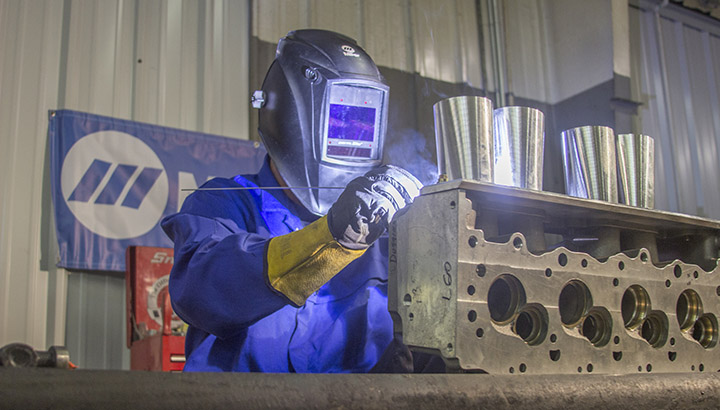Usual Welding Repair Issues and How to Address Them Effectively
Welding fixings usually run into a series of concerns that can jeopardize the stability of the end product. Common issues include poor penetration, porosity, and imbalance, to name a few. Each issue provides special difficulties that call for details approaches for resolution. Understanding these issues is vital for welders aiming to boost their results and skills. This conversation will discover these typical welding repair service problems and reliable techniques to address them.
Insufficient Penetration
Insufficient penetration takes place when the weld steel falls short to completely fuse with the base product, resulting in weak joints and potential structural failings. This issue typically originates from not enough warm input, incorrect electrode angle, or incorrect welding rate. Welders might run into inadequate penetration as a result of a mistake of the essential parameters for a certain product thickness or type. Furthermore, contamination on the base material's surface can impede reliable bonding, worsening the trouble. To resolve poor penetration, welders ought to ensure appropriate settings on their tools and maintain a tidy work surface. Regular examination of welds is suggested to recognize any deficiencies early, permitting timely modifications and the prevention of endangered structural integrity in welded settings up.
Porosity
Porosity is a typical flaw in bonded joints that shows up as tiny gas bubbles trapped within the weld steel. This problem can compromise the integrity of the weld, bring about lowered strength and prospective failing under stress. Montana Mobile Welding and Repair Fabrication. Porosity generally occurs from contamination, moisture, or inappropriate welding methods, which permit gases to escape into the molten weld pool. To deal with porosity, welders need to guarantee correct surface preparation, keep a tidy functioning setting, and make use of ideal welding criteria. In addition, picking the right filler product and shielding gas can minimize gas entrapment. Normal examination and screening of welds can aid recognize porosity early, ensuring prompt restorative actions are taken, thus maintaining the top quality and reliability of the welded structure
Imbalance
Misalignment in welding can develop from numerous aspects, consisting of inappropriate setup and thermal expansion. Recognizing the origin is essential for reliable resolution. A number of adjustment strategies are readily available to straighten elements and assure structural stability.
Reasons for Imbalance
Welding misalignment commonly originates from a range of underlying problems that can compromise architectural honesty. One key cause is inappropriate fit-up of parts prior to welding, which can bring about spaces and unequal surfaces. Variants in thermal expansion throughout the welding procedure can also lead to distortion, particularly if the products being joined have different coefficients of development. Furthermore, insufficient clamping and fixturing may fail to hold components firmly in location, bring about activity during welding. Inadequately kept tools, including welding devices and tools, may introduce incongruities in the weld grain, additional contributing to imbalance. Driver error, stemming from not enough training or experience, can additionally play a significant duty in creating misaligned welds.

Correction Strategies Readily Available
Attending to imbalance properly requires a combination of corrective techniques customized to the details problems available. One typical method is making use of jigs or components to hold components in the proper position throughout welding, making certain regular positioning. In addition, preheating the products can help in reducing distortion and boost fit-up. For substantial imbalance, mechanical realignment techniques, such as utilizing hydraulic jacks or clamps, can be used to fix the setting prior to welding. Post-weld warmth therapy may also be needed to soothe stresses brought on by misalignment. Finally, cautious assessment and modification during the configuration phase can stop misalignment problems from coming to be substantial troubles, promoting a smoother welding procedure and improving general structural integrity.
Distortion
Distortion is a common challenge in welding that can arise from different variables, consisting of uneven heating and cooling. Comprehending the reasons of distortion is important for carrying out efficient prevention strategies. Addressing this problem not only enhances structural honesty yet also improves the general high quality of the weld.
Root causes of Distortion
When based on the intense warm of welding, products frequently go through adjustments that can bring about distortion. This phenomenon mainly emerges from thermal development and contraction during the welding process. As the weld area heats up, the product expands; upon air conditioning, it acquires, which can create interior anxieties. On top of that, uneven home heating throughout a workpiece can intensify these stresses, leading to warping or bending. The kind of product likewise plays a look these up considerable role; steels with differing thermal conductivity and coefficients of expansion may respond in different ways, leading to unforeseeable distortions. Bad joint design and poor fixturing can contribute to misalignment throughout welding, increasing the likelihood of distortion. Comprehending these causes is important for efficient welding fixing and avoidance methods.
Prevention Techniques
Effective prevention methods for distortion during welding concentrate on controlling warm input and making sure correct joint design. Preserving a regular heat input helps to lessen thermal growth and tightening, which can bring about distortion. Utilizing techniques such as pre-heating the work surface can also lower the temperature slope, promoting consistent home heating. In like this addition, choosing suitable joint styles, such as T-joints or lap joints, can improve security and lower stress concentrations. Implementing proper fixturing to secure the work surfaces in place better aids in maintaining alignment during the welding process. Lastly, staggered welding sequences can disperse heat a lot more equally, avoiding local distortion. By applying these techniques, welders can significantly reduce the probability of distortion and improve the overall quality of their welds.
Breaking
Breaking is a common problem run into in welding fixings, typically resulting from various factors such as inappropriate air conditioning prices, material choice, or insufficient joint preparation. The occurrence of cracks can considerably jeopardize the integrity of the weld, resulting in prospective failures throughout operation. To resolve this concern, welders have to first assess the origin, making sure that materials work and appropriately selected for the specific application. Furthermore, controlling go the air conditioning price throughout the welding procedure is vital; quick air conditioning can generate stress and anxiety and cause breaking. Appropriate joint layout and preparation likewise add to decreasing the danger. Implementing these strategies can improve weld quality and durability, ultimately lowering the probability of cracking in finished weldments.

Incomplete Fusion
A substantial problem in welding repairs is incomplete fusion, which takes place when the weld metal does not adequately bond with the base material or previous weld passes - Belgrade Fabrication. This defect can cause weak points in the joint, possibly jeopardizing the stability of the bonded structure. Factors contributing to incomplete fusion include not enough heat input, inappropriate welding technique, and contamination of the surface areas being signed up with. To resolve this problem effectively, welders should guarantee proper pre-weld cleaning and surface area preparation, along with adjust their welding criteria to achieve sufficient infiltration and combination. Routine evaluation throughout the welding procedure can additionally help recognize incomplete fusion early, allowing for timely rehabilitative actions to boost the total top quality of the weld
Overheating
While welding repair work can improve structural honesty, overheating presents a considerable obstacle that can lead to material deterioration. Too much warmth during welding can alter the mechanical residential or commercial properties of steels, causing lowered toughness, raised brittleness, and warping. This phenomenon is especially critical in high-stress applications where structural dependability is critical. Recognizing getting too hot can include aesthetic examinations for staining or distortion, as well as keeping track of temperature during the welding procedure. To alleviate the dangers related to overheating, welders should employ suitable strategies, such as managing warm input, changing travel speed, and utilizing suitable filler products. Furthermore, executing pre- and post-weld warm treatments can help bring back material residential or commercial properties and improve the general top quality of the repair service, making sure lasting efficiency and safety and security.
Frequently Asked Questions
What Are the Usual Signs of a Welding Defect?

How Can I Examine My Welds for Quality?
To check welds for top quality, one can make use of visual inspections, ultrasonic screening, and radiographic techniques. Each method ensures architectural integrity, recognizes issues, and verifies adherence to defined standards, inevitably improving the dependability of the bonded joints.
What Security Safety Measures Should I Take While Welding?
When welding, one ought to prioritize safety by putting on appropriate individual protective equipment, ensuring appropriate ventilation, securing flammable products away, maintaining a tidy office, and being mindful of environments to avoid crashes and injuries.
Can I Fix a Weld Without Redoing the Entire Joint?
Fixing a weld without redesigning the entire joint is possible, depending upon the damage (Belgrade Fabrication). Strategies such as grinding, adding filler material, or using a welding procedure can efficiently deal with details imperfections while maintaining the bordering framework
What Tools Are Vital for Effective Welding Fixes?
Vital tools for reliable welding repairs consist of a welding machine, cable brush, grinder, protective equipment, clamps, and filler materials. Each device plays an important function in making sure top quality and security during the repair work process. Porosity normally occurs from contamination, dampness, or improper welding strategies, which permit gases to run away into the molten weld swimming pool. Badly conserved equipment, including welding machines and devices, might present incongruities in the weld grain, additional adding to misalignment. When subjected to the intense heat of welding, products commonly go through modifications that can lead to distortion. Splitting is an usual concern come across in welding repair services, often resulting from numerous factors such as improper cooling rates, material choice, or inadequate joint preparation. A significant problem in welding fixings is insufficient blend, which happens when the weld steel does not sufficiently bond with the base material or previous weld passes.